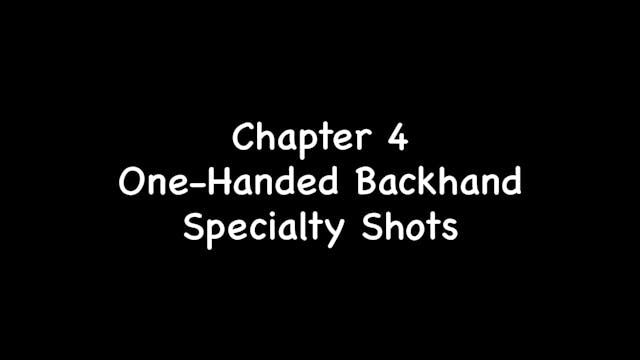The Intuitive One-Handed Backhand (28 Lessons)
The one-handed backhand is biomechanically one of the simplest shots in tennis. The forehand or the serve, for example, are far more complex. However, most recreational tennis players and even some high-level players have a weak backhand.
So if the backhand is so simple, how do so many players struggle with it?
The answer is quite simple. On the one-handed backhand, we are using the backside of the arm, which happens to be the weaker side. It is not surprising that many players are therefore playing the backhand with two hands.
Why don't we just play the two-handed backhand?
My research has shown that while most high-level players use a two-handed backhand, most recreational players do not. Adult male recreational players who started playing later in life usually find the one-handed backhand easier than the two-hander. The two-hander often feels cramped, and players experience a reduced range of motion. However, while it's easier to strike the ball with one arm on the backhand wing, most recreational players DO IT WRONG.
They are using the arm in isolation. And since the one-handed backhand is struck with the weak side of the arm, players often experience a lack of power and control.
Therefore, it is of the utmost importance that the body supports the arm. When the one-handed backhand is executed with its various power sources working in unison, it turns into an effortless, powerful shot.
Think of Federer, Tsitsipas or Wawrika. The amount of power these players are able to produce is staggering. But it's not only that.
They look cool doing it.
Let's face it
When the one-handed backhand is executed correctly, it is possibly the most elegant and aesthetically pleasing stroke in tennis.
And there is a reason why it looks that way.
To look effortless, it has to have fundamentals that allow players to use their body most optimally, so the arm is fully supported.
But it's not only that.
Players with one-handed backhands have an advantage.
Since they use one arm on the backhand wing, they usually have more variety on that side. The backhand volley, drop shot, lob, slice, chip, bunt, and block are all strokes that are better with one arm. So players who have a one-handed backhand are usually more competent with these specialty-type shots.
Can a two-handed backhand player benefit from learning a one-handed backhand?
Absolutely.
I have a two-handed backhand. I consider it my best shot. However, in juniors, my weak spots were the backhand slice and the backhand volley. I did not use them much. However, once I got to college, I was inspired by my coach Mel Purcell who was a top 20 ATP player with one of the coolest bunt one-handed backhands I have ever seen. So I began practicing the one-handed backhand, and guess what?
Not only did I learn the hit a very good one-hander but also developed great feel playing with one arm on the backhand wing. My slice got better, and so did my drop shot, volley, chip, block, and most importantly (for me) the bunt, which is one of my favorite shots ever.
Learning the one-handed backhand has improved my game remarkably, and it's going to benefit yours as well. Whether you have a one-handed and want to improve it or are a two-handed player like me and want to add variety, the INTUITIVE ONE-HANDED BACKHAND COURSE will help you do just that.
It is my most comprehensive work yet. It covers every shot on the backhand wing struck with one arm, including the slice, chip, block, bunt, lob, and much more...
Why did I name it the INTUITIVE ONE-HANDED BACKHAND?
Here's the crazy thing.
If you learn the fundamentals of each of these backhand strokes, set them up correctly, and intend to finish them the right way, they will become more intuitive. In other words, small intricate technical details will take care of themselves, and you'll never have to worry about them. With enough repetition and patience, all you will have to do is to
JUST LET THE ONE-HANDER RIP
Length of Course: 1 hour 18 minutes
-
Chapter 1 (One-Handed Backhand Fundamentals)
1. Grips
2. Three Part Sequence
3. Stances
4. The Stroke
5. Timing
6. The Intuitive Zone
7. Flat vs Spin
8. Hit Through the Ball Myth
Chapter Length: 33:21 -
Chapter 2 (One-Handed Backhand Power & Control)
9. The 4 Power Sources
10. The One-Handed Backhand is Naturally Weak
11. Control
Chapter Length: 9:03 -
Chapter 3 (One-Handed Backhand Slice)
12. Don't Overuse the Slice
13. Grips
14. Three Part Sequence + Stances
15. The Stroke
16. The Intuitive Zone
17. Underspin vs Sidespin
18. Hit Through the Ball Myth
Chapter Length: 16:10 -
Chapter 4 (One-Handed Backhand Specialty Shots)
19. Advantage One-Handers
20. Slice Approach Shot
21. Short Angle Backhand
22. Topspin Lob
23. Chip, Block, Bunt & Dropshot
24. Return of Serve
25. High Backhands & Low Backhands
26. Inside Out Backhands
27. Defensive Backhands
28. Don't Hit Backhands
Chapter Length: 20:10





